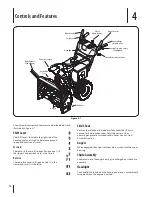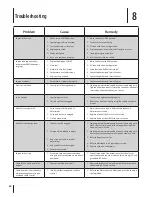
Tire Pressure
The tires are over-inflated for shipping purposes. Check the tire
pressure before operating the snow thrower. Refer to the tire side
wall for tire manufacturer’s recommended psi and deflate (or
inflate) the tires as necessary.
WARNING:
Under any circumstance do not exceed
manufacturer’s recommended psi. Equal tire
pressure should be maintained at all times. Excessive
pressure when seating beads may cause tire/rim
assembly to burst with force sufficient to cause
serious injury. Refer to sidewall of tire for
recommended pressure.
NOTE:
Equal tire pressure is to be maintained at all times for
performance purposes.
Adjustment
Skid Shoes
The snow thrower skid shoes are adjusted at the factory. Adjust
them downward, if desired, prior to operating the snow thrower.
CAUTION:
It is not recommended that you operate this snow
thrower on gravel as it can easily pick up and throw loose gravel,
causing personal injury or damage to the snow thrower and
surrounding property.
•
For close snow removal on a smooth surface, raise skid
shoes higher on the auger housing.
•
Use a middle or lower position when the area to be cleared
is uneven, such as a gravel driveway.
NOTE:
If you choose to operate the snow thrower on a gravel
surface, keep the skid shoes in position for maximum clearance
between the ground and the shave plate.
To adjust the skid shoes:
1.
Loosen the four hex nuts (two on each side) and carriage
bolts. Move skid shoes to desired position. See Fig. 3-13,
Fig. 3-14 or Fig. 3-15.
2.
Make certain the entire bottom surface of skid shoe is
against the ground to avoid uneven wear on the skid shoes.
3.
Retighten nuts and bolts securely.
NOTE:
Some models are equipped with reversible skid shoes
and may be turned over to increase their lifespan.
Fig. 3-13
Fig. 3-14
Fig. 3-15
10
S
ection
3— A
SSembly
& S
et
-U
p
Summary of Contents for 3X
Page 24: ...24 Notes ...
Page 25: ...Notes 24 ...











































